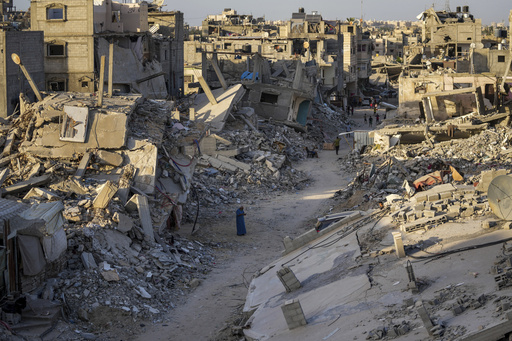U.N. agencies have consistently cautioned that rebuilding Gaza after Israel’s military actions against Hamas could take decades. However, with the conflict now extending into its second year, a recent report suggests this timeframe may stretch to centuries. According to the U.N. Conference on Trade and Development, a report released on Monday indicates that even if the war were to conclude today and Gaza returned to its pre-attack conditions from October 7, 2023, it could take an astonishing 350 years for the region’s economy to recover to levels seen before the conflict.
Prior to the onset of the war, Gaza was already grappling with an Israeli and Egyptian blockade that began when Hamas took control in 2007. The economic strain on Gaza resulted from four previous military confrontations, as well as political divisions between Hamas and the Palestinian Authority, which is backed by the West. The ongoing conflict has devastated the territory, leaving neighborhoods in ruins, with significant damage to essential infrastructure. The landscape is now dotted with rubble containing decomposed bodies and unexploded munitions, which must be cleared for any rebuilding efforts to commence.
The report emphasizes that a return to the pre-war status quo would not be a viable path toward recovery or sustainable development. If the economic growth trend from 2007 to 2022, which averaged a mere 0.4 percent, were to resume, it would take 350 years to restore Gaza’s GDP to what it was in 2022. Furthermore, even with such a recovery, the report notes that GDP per capita would continue to decrease rapidly as the population grows.
Rami Alazzeh, the report’s author, clarified that the 350-year estimate is more of a calculative projection rather than a definitive prediction. He emphasized that this calculation stemmed from the economic destruction witnessed during the first seven months of the ongoing war, alongside the historical average GDP growth rate for the region. He stated, “The recovery in Gaza depends on the conditions under which it occurs.” Far from asserting that Gaza would never recover, Alazzeh aims to highlight the need for appropriate circumstances for rebuilding efforts to take place.
In late January, the World Bank assessed the damage incurred at approximately $18.5 billion, a figure nearly equivalent to the total economic output of both the West Bank and Gaza combined for the year 2022. This assessment was made prior to further destructive military operations in southern cities like Rafah. A U.N. evaluation conducted in September, utilizing satellite imagery, revealed that about 25% of all structures in Gaza had either been destroyed or significantly damaged. An estimated 66% of buildings, including more than 227,000 residential properties, suffered at least mild damage.
The Shelter Cluster, an international coalition led by the Norwegian Refugee Council, estimated the duration required to reconstruct all destroyed homes based on an established mechanism initiated post-2014 conflict. Their findings indicated that completing the reconstruction under the set framework would demanding up to 40 years.
Despite this, the report notes that even in the most favorable scenarios, recovery would still extend over decades. It postulates that if military operations ceased, along with the unrestricted flow of goods and people and substantial investment, Gaza’s GDP per capita might reach its 2022 levels by 2050. In a separate report from the U.N. Development Program, it was suggested that with substantial investments and the lifting of economic restrictions, the Palestinian economy, including the West Bank, could start to regain stability by 2034. However, without these conditions, predictions remain bleak and align with the UNCTAD’s outlook.
Unfortunately, the chances of these optimistic scenarios materializing appear slim. Since Hamas militants’ attack on October 7, which resulted in approximately 1,200 deaths—predominantly among civilians—and the abduction of about 250 individuals, the toll on both sides continues to rise. Israeli military actions have claimed the lives of over 42,000 Palestinians, as per local health officials. Though it is difficult to separate combatants from civilians in these statistics, it is reported that more than half of the fatalities are women and children. Roughly 90% of Gaza’s population, totaling 2.3 million, has been displaced, and many find themselves living in inadequate tent camps.
Israel maintains that the blockade is essential to prevent Hamas from acquiring weaponry and has shown no intention of lifting it while the group remains active in the region. Prime Minister Benjamin Netanyahu has expressed Israel’s commitment to maintaining indefinite security oversight of Gaza. Since May, Israel has also controlled all of Gaza’s border crossings, limiting the ability of U.N. agencies and humanitarian groups to deliver food and emergency relief due to ongoing military operations and deteriorating law and order in the area.
Moreover, there is no indication that international donors are inclined to finance Gaza’s reconstruction as long as hostilities persist or the region remains under Israeli control. Nations in the Arab Gulf, including Saudi Arabia and the UAE, have stated they would only consider contributions if a pathway to Palestinian statehood were established—a condition strongly opposed by Israeli leadership.
As the conflict continues with no resolution in sight, Israel has initiated further military operations in northern Gaza, the area most heavily impacted by destruction, citing Hamas’s resurgence there. Alazzeh remarked, “Everyone now calls for a ceasefire, but people forget that once a ceasefire is reached, the 2.2 million Palestinians will awaken to find no homes, no schools for children, no universities, no hospitals, no roads.” He emphasized that the monumental task of rebuilding could be rendered nearly impossible under the ongoing blockade.
Alazzeh concluded, “If we revert back to the previous situation, and we should not, it suggests that Gaza’s future may be entirely bleak.”
